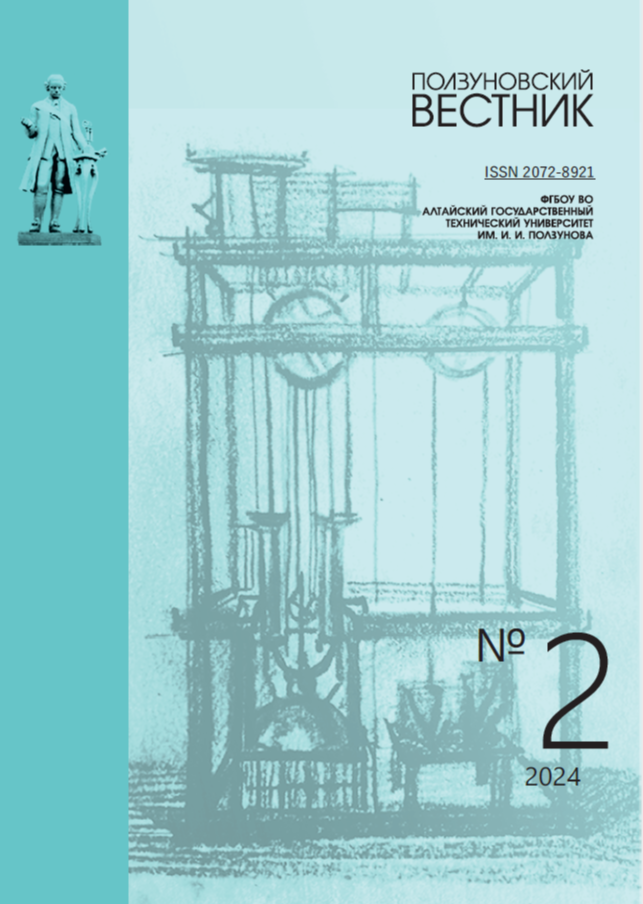DEVELOPMENT OF LYOPHILIZATION TECHNOLOGY AND OPTIMIZATION OF CRYOPROTECTANTS TO IMPROVE CO-CULTIVATION OF BACILLUS COAGULANS AND STREPTOCOCCUS THERMOPHILUS BACTERIA
CNLNIL
DOI:
https://doi.org/10.25712/ASTU.2072-8921.2024.02.005Keywords:
cryoprotectant research, Bacillus coagulans, Streptococcus thermophilus, food industry, sucrose, freezing damage, co-culture, quantum-chemical calculations, optimal preservation methods, microbial culturesAbstract
Microorganisms play an important role in various fields, including biotechnology, food processing, pharmaceuticals and the environment. However, preserving the viability and genetic stability of microorganisms during storage and transportation is challenging. In order to ensure efficient operation and obtain reliable results, it is necessary to develop an optimal method for the preservation of microbial cultures. The aim of the study is to develop an effective lyophilization technology and selection of cryoprotectants to improve the co-culture of Bacillus coagulans and Streptococcus thermophilus. Co-culturing of these bacteria is essential to obtain high quality products with desired properties. Proper lyophilization technology and the addition of cryoprotectants have made it possible to significantly reduce the damage caused by freezing and to successfully culture the two bacteria. Sucrose is found to be one of the most effective cryoprotectants in this study. It showed the best result in a 3:1 ratio with the bacterial mass. Quantum chemical calculations were performed to evaluate the effectiveness of sucrose as a cryoprotectant. The results of the calculations confirmed that sucrose is an effective cryoprotectant for Bacillus coagulans and Streptococcus thermophilus bacteria. It should be noted that the development of an optimal method of preservation is crucial for effective work and reliable results in the cultivation of microbial cultures. The study showed that the correct choice of lyophilization technology and the addition of cryoprotectants, in particular sucrose, can significantly improve the co-cultivation of Bacillus coagulans and Streptococcus thermophilus. This finding has practical implications for the food industry and other fields in which microorganisms are used
References
Sompach, G., Rodklongtan, A., Nitisin-prasert, S., Chitprasert, P. Microencapsulating Role of Whey Protein Isolate and Sucrose in Protecting the Cell Membrane and Enhancing Survival of Probiotic Lactobacilli Strains during Spray Drying, Storage, and Simulated Gastrointestinal Passage. Food Re-search International 2022, 159, 111651. https://doi.org/ 10.1016/j.foodres.2022.111651.
Huang, S., Vignolles, M.-L., Chen, X.D., Le Loir, Y., Jan, G., Schuck, P., Jeantet, R. Spray Drying of Probiotics and Other Food-Grade Bacteria: A Re-view. Trends Food Sci Technol 2017, 63, 1-17. https://doi.org/10.1016/j.tifs.2017.02.007.
Merivaara, A., Zini, J., Koivunotko, E., Valko-nen, S., Korhonen, O., Fernandes, F.M., Yliperttula, M. Preservation of Biomaterials and Cells by Freeze-Drying: Change of Paradigm. Journal of Controlled Release 2021, 336, 480-498. https://doi.org/10.1016/j.jconrel.2021.06.042.
Estilarte, M.L., Tymczyszyn, E.E., Ser-radell, M. de los Á., Carasi, P. Freeze-Drying of En-terococcus Durans: Effect on Their Probiotics and Biopreservative Properties. LWT 2021, 137, 110496. https://doi.org/10.1016/j.lwt.2020.110496.
Bellali, S., Bou Khalil, J., Fontanini, A., Ra-oult, D., Lagier, J.-C. A New Protectant Medium Pre-serving Bacterial Viability after Freeze Drying. Micro-biol Res 2020, 236, 126454. https://doi.org/ 10.1016/j.micres.2020.126454.
Câmara Júnior, A. de A., Nguyen, T.D., Jossier, A., Endrizzi, A., Saurel, R., Simonin, H., Hus-son, F. Improving Total Glutathione and Trehalose Contents in Saccharomyces Cerevisiae Cells to En-hance Their Resistance to Fluidized Bed Drying. Pro-cess Biochemistry 2018, 69, 45-51. https://doi.org/10.1016/j.procbio.2018.03.013.
Mohideen Batcha, M.F., Amirnordin, S.H., Md Yudin, A.S. Fluidized Bed Dryers. In Drying Tech-nology in Food Processing; Elsevier, 2023; pp. 67-122. https://doi.org/10.1016/B978-0-12-819895-7.00006-7.
Vorländer, K., Bahlmann, L., Kwade, A., Finke, J.H., Kampen, I. Effect of Process Parameters, Protectants and Carrier Materials on the Survival of Yeast Cells during Fluidized Bed Granulation for Tableting. Pharmaceutics 2023, 15 (3), 884. https://doi.org/10.3390/pharmaceutics15030884.
Wolkers, W.F., Oldenhof, H., Tang, F., Han, J., Bigalk, J., Sieme, H. Factors Affecting the Membrane Permeability Barrier Function of Cells du-ring Preservation Technologies. Langmuir 2019, 35 (23), 7520-7528. https://doi.org/10.1021/ acs.langmuir.8b02852.
Mizuno, M., Matsuzaki, T., Ozeki, N., Kata-no, H., Koga, H., Takebe, T., Yoshikawa, H.Y., Sekiya, I. Cell Membrane Fluidity and ROS Resistance De-fine DMSO Tolerance of Cryopreserved Synovial MSCs and HUVECs. Stem Cell Res Ther 2022, 13 (1), 177. https://doi.org/10.1186/s13287-022-02850-y.
Mazur, P., Leibo, S.P., Chu, E.H.Y. A Two-Factor Hypothesis of Freezing Injury. Exp Cell Res 1972, 71 (2), 345-355. https://doi.org/10.1016/0014-4827(72)90303-5.
Murray, K.A., Gibson, M.I. Chemical Ap-proaches to Cryopreservation. Nat Rev Chem 2022, 6 (8), 579-593. https://doi.org/10.1038/s41570-022-00407-4.
Alves, N.J., Turner, K.B., Medintz, I.L., Walper, S.A. Protecting Enzymatic Function through Directed Packaging into Bacterial Outer Membrane Vesicles. Sci Rep 2016, 6 (1), 24866. https://doi.org/10.1038/srep24866.
Yang, J., Pan, C., Zhang, J., Sui, X., Zhu, Y., Wen, C., Zhang, L. Exploring the Potential of Bio-compatible Osmoprotectants as Highly Efficient Cry-oprotectants. ACS Appl Mater Interfaces 2017, 9 (49), 42516-42524. ttps://doi.org/10.1021/acsami.7b12189.
Zachariassen, K.E., Kristiansen, E. Ice Nu-cleation and Antinucleation in Nature. Cryobiology 2000, 41 (4), 257-279. https://doi.org/10.1006/ cryo.2000.2289.
Gao, W., Smith, D.W., Li, Y. Effects of Freez-ing on the Survival of Escherichia Coli and Bacillus and Response to UV and Chlorine After Freezing. Water Environment Research 2007, 79 (5), 507-513. https://doi.org/10.2175/106143006X115426.
Raju, R., Bryant, S.J., Wilkinson, B.L., Bry-ant, G. The Need for Novel Cryoprotectants and Cry-opreservation Protocols: Insights into the Importance of Biophysical Investigation and Cell Permeability. Biochimica et BiophysicaActa (BBA) - General Sub-jects 2021, 1865 (1), 129749. https://doi.org/10.1016/j.bbagen.2020.129749.
Hasan, M., Fayter, A.E.R., Gibson, M.I. Ice Recrystallization Inhibiting Polymers Enable Glycer-ol-Free Cryopreservation of Microorganisms. Biom-acromolecules 2018, 19 (8), 3371-3376. https://doi.org/ 10.1021/acs.biomac.8b00660.
Kommineni, N., Butreddy, A., Sainaga Jyothi, V.G.S., Angsantikul, P. Freeze-Drying for the Preservation of Immunoengineering Products. i Sci-ence 2022, 25 (10), 105127. https://doi.org/10.1016/ j.isci.2022.105127.
Dumont, F., Marechal, P.-A., Gervais, P. Cell Size and Water Permeability as Determining Factors for Cell Viability after Freezing at Different Cooling Rates. Appl Environ Microbiol 2004, 70 (1), 268-272. https://doi.org/10.1128/AEM.70.1.268-272.2004.
Downloads
Published
How to Cite
Issue
Section
License
Copyright (c) 2024 Mariia S. Ashikhmina, Vasilisa F. Krasnova, Olga Yu. Orlova, Sviatlana A. Ulasevich, Ekaterina V. Skorb

This work is licensed under a Creative Commons Attribution 4.0 International License.















 .
. This work is licensed under a
This work is licensed under a 
